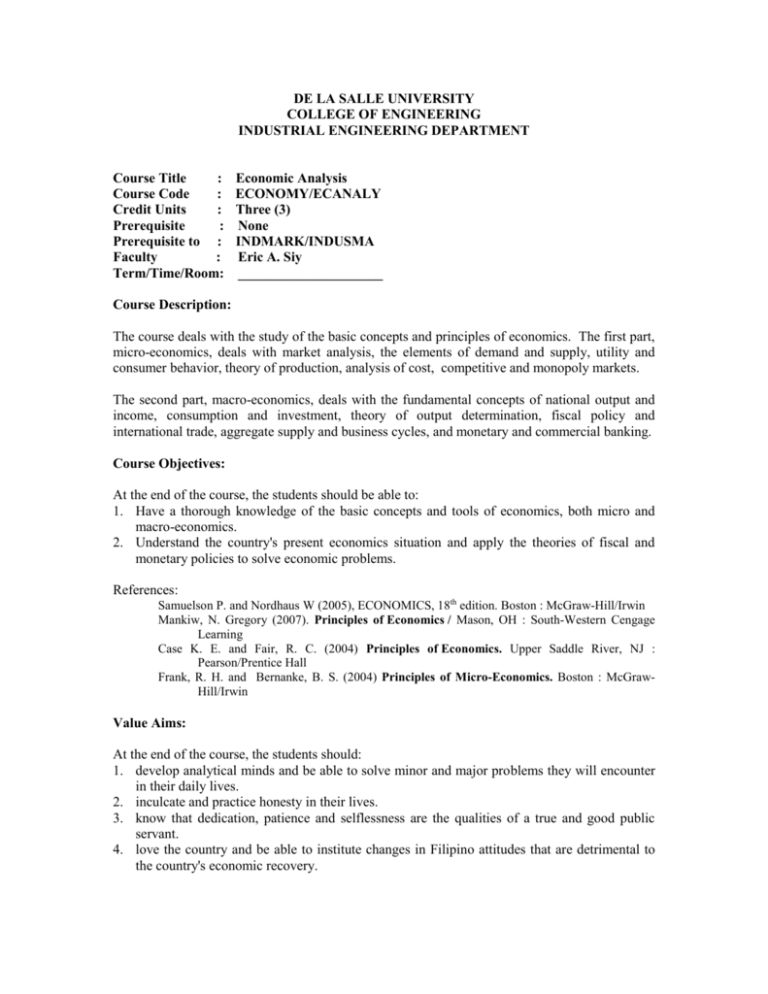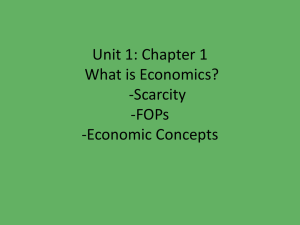
DE LA SALLE UNIVERSITY
COLLEGE OF ENGINEERING
INDUSTRIAL ENGINEERING DEPARTMENT
Course Title
:
Course Code
:
Credit Units
:
Prerequisite
:
Prerequisite to :
Faculty
:
Term/Time/Room:
Economic Analysis
ECONOMY/ECANALY
Three (3)
None
INDMARK/INDUSMA
Eric A. Siy
_____________________
Course Description:
The course deals with the study of the basic concepts and principles of economics. The first part,
micro-economics, deals with market analysis, the elements of demand and supply, utility and
consumer behavior, theory of production, analysis of cost, competitive and monopoly markets.
The second part, macro-economics, deals with the fundamental concepts of national output and
income, consumption and investment, theory of output determination, fiscal policy and
international trade, aggregate supply and business cycles, and monetary and commercial banking.
Course Objectives:
At the end of the course, the students should be able to:
1. Have a thorough knowledge of the basic concepts and tools of economics, both micro and
macro-economics.
2. Understand the country's present economics situation and apply the theories of fiscal and
monetary policies to solve economic problems.
References:
Samuelson P. and Nordhaus W (2005), ECONOMICS, 18th edition. Boston : McGraw-Hill/Irwin
Mankiw, N. Gregory (2007). Principles of Economics / Mason, OH : South-Western Cengage
Learning
Case K. E. and Fair, R. C. (2004) Principles of Economics. Upper Saddle River, NJ :
Pearson/Prentice Hall
Frank, R. H. and Bernanke, B. S. (2004) Principles of Micro-Economics. Boston : McGrawHill/Irwin
Value Aims:
At the end of the course, the students should:
1. develop analytical minds and be able to solve minor and major problems they will encounter
in their daily lives.
2. inculcate and practice honesty in their lives.
3. know that dedication, patience and selflessness are the qualities of a true and good public
servant.
4. love the country and be able to institute changes in Filipino attitudes that are detrimental to
the country's economic recovery.
ECONOMY Course Syllabus
Page 2
******************************************************************************
Course Outline:
Week
1
Topic
1. Basic economic concepts
1.1 Introduction
- definition of economics
- micro-economics vs. macro-economics
- uses of economics
- economics in government
- production possibility frontier
1.2 Nature of economics
- wants and utilities
- production of utilities
- factors of production
- consumption and production
- scarcity and choice
- opportunity cost
At the end of this unit, the students must be able to:
1. define the meaning of economics and distinguish
macroeconomics from microeconomics.
2. appreciate the concept of economics as applied in our everyday
lives.
3. define the concepts of utilities, wants, scarcity, and opportunity
cost
4. know the factors of production.
2
2. Micro-economics
2.1 Basic problems of economic organization
- input and output
- alternative economic
- society's technological possibilities
- scarcity law and law of diminishing returns
- how markets solve the basic economic problem
- market mechanism and prices
- economic role of government
- specialization and division of labor
- money and capital
At the end of this unit, the students must be able to:
1. know alternative economic systems.
2. define the scarcity law and law of diminishing returns and given
examples of real life manifestations of these laws.
3. know how markets operate and the role of prices in this operation.
4. define the role of government in price regulation.
ECONOMY Course Syllabus
Page 3
******************************************************************************
Week
Topic
5. know what are the advantages and disadvantages of specialization
and division of labor in an economy.
6. define how money and capital affects an economy.
2, 3
2.2 Elements of supply and demand
- demand schedule and demand curve
- supply schedule and supply curve
- equilibrium of demand and supply
- price elasticity of demand
- price elasticity of supply
- momentary, short-run, long-run equilibrium
- equity through taxes
- efficiency of markets
At the end of this unit, the students must be able to:
1. Know how to construct a demand or supply schedule and learn how
to draw a demand or supply curve.
2. Know how to determine the equilibrium quantity and price from
demand and supply curves.
3. Know how to compute for demand and supply elasticity's.
4. Know how to determine momentary, short-run and long-run
equilibrium and apply these concepts in real life situations.
5. Know how government intervenes in the determination of
equilibrium prices by means of imposing taxes.
4
2.3 Demand, utility and consumer behavior
- choice and utility theory
- marginal utility
- indifference curves
- law of substitution
- income effect
At the end of this unit, the student must be able to:
1. Define choice and utility theory and give examples on how these
theories apply to real life situations.
2. Know the concept of marginal utility and indifference curves.
3. Define the law of substitution and illustrate the application of this
law in specific situations.
4. Know how income affects consumer behavior and the demand curve.
QUIZ NO. 1
5
2.4 Theory of production and marginal products
- production function
- total product, average product, marginal product
- technological change
- aggregate production function
ECONOMY Course Syllabus
Page 4
******************************************************************************
Week
Topic
6
2.5 Analysis of cost
- total cost, fixed and variable
- marginal cost, average cost, opportunity cost
- link between production and cost
- choice of firm's inputs
- least-cost factor combination
At the end of this unit, the student must be able to:
1. Know how to compute total, fixed, variable, marginal and average
costs.
2. Determine how cost affects production and the choice of production
inputs
3. Know the least-cost factor combination.
7
2.6 Competitive supply the competitive markets
- competitive supply and marginal cost
- perfect competition
- supply behavior in competitive markets
- efficiency in competitive markets
At the end of this unit, the student must be able to:
1. Understand the relationship of supply and marginal cost.
2. Define perfect competition
3. Know the different behaviors in competitive market
2.7 Monopoly: Analysis and regulation
- patterns of imperfect competition
- behavior of imperfect competition
- analysis of monopoly
- price, quantity and total revenues
- cost control and monopoly
- economic regulation of monopoly
At the end of this unit, the student must be able to:
1. Define the meaning of monopoly.
2. Know what is imperfect competition and behavior of imperfect
competitors in the market.
3. Know how to control cost in monopoly situations.
4. Familiarize himself on how the government regulates monopoly.
8
3. Macro-economics
3.1 Macro-economics fundamental concepts
- major objectives of macro-economics
- macro-economic policies
- aggregate demand and supply
ECONOMY Course Syllabus
Page 5
******************************************************************************
Week
Topic
At the end of this unit, the student must be able to:
1. Know the concept of macro-economics.
2. Determine the difference of micro and macro-economics.
3. Be familiar with the economic policies of the Philippine government.
3.2 Measurement of national output and income
- GNP, real vs. nominal GNP, NNP
- two measures of national product
- disposable income, net economic welfare.
At the end of this unit, the student must be able to:
1. Define GNP, NNP and disposable income.
2. Solve problems in the determination of real GNP
3. Know the two measures of national product
4. Define net economic welfare.
9
3.3 Consumption and investment
- budgetary expenditure patterns
- consumption function, income and savings
- marginal propensity to consume
- marginal propensity to save
- national consumption behavior
- determinants of investment
- policy channels on investment
- investment demand curve
At the end of this unit, the student must be able to:
1. Determine how to compute for marginal propensity to consume and
save and the significance of the values obtained for each.
2. Know the determinants and policy channels of investment.
3. Appreciate the value of investment in an economy
4. Determine how to derive a consumption function
10
3.4 Theory of output determination
- analytical foundations of aggregate demand
- aggregate demand curve
- determinants of aggregate supply and potential output
- output determination, multiplier model
At the end of this unit, the student must be able to:
1. Know how aggregate demand is derived
2. Compute for aggregate demand
3. Determine what are the factors that affect aggregate demand and
supply.
4. Be familiar with the multiplier model of output determination.
ECONOMY Course Syllabus
Page 6
******************************************************************************
Week
Topic
11
3.5 Fiscal policy and international trade
- impact of fiscal policy
- fiscal policy multipliers
- impacts of foreign trade on economic activity
At the end of this unit, the student must be able to:
1. Determine the impact of fiscal policy on national economy.
2. Know the mechanics of international trade.
12
3.6 Aggregate supply and business cycles
- source of potential output growth
- supply side of economics
- business cycle theories
- forecasting business cycles
At the end of this unit, the student must be able to:
1. Determine the source of potential output growth.
2. Be familiar with several business cycle theories.
3. Know how business cycles are forecasted and the indicators needed
in forecasting.
QUIZ NO. 3
13
3.7 Money and commercial banking
- components of money supply
- motives for holding money
- banking and supply of money
- legal reserve requirements
- process of deposit creation
- monetary policy to control spending
At the end of this unit, the student must be able to:
1. Be familiar with the components of money supply
2. Know the motives for holding money
3. Be familiar with the commercial banking system.
4. Know the role of money in an economy.
5. Be familiar with legal reserve requirements.
6. Determine the processes involved in deposit creation.
7. Know the monetary policy to control spending.
FINAL EXAMINATIONS
ECONOMY Course Syllabus
Page 7
******************************************************************************
Course Policies:
1. Grading System
Average of three (3) quizzes
Final Exam
Short quizzes and assignments
TOTAL
60%
30%
10%
100%
2. Quizzes/Finals
2.1
No make-up examinations will be given. All missed quizzes will be equivalent to zero.
2.2
All major quizzes and final examinations will be departmentalized.
3. Cheating
Anyone caught cheating or trying to cheat in any manner will be given a final grade of
0.0.
4.
Absences
The maximum allowable absences is 7.5 hrs. Anyone who exceeds this limit will be
given a final grade of 0.0.










